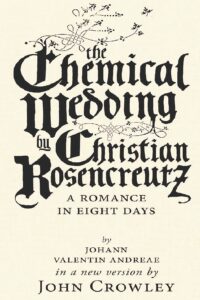Or, more properly and to give the book its full era-appropriate title, The Chemical Wedding by Christian Rosencreutz, A Romance in Eight Days, by Johann Valentin Andreae in a new version by John Crowley
Cheekily claimed as a special 400th anniversary edition, The Chemical Wedding is a new version of one of the founding Rosicrucian documents, an allegorical text from 1616 first published in German, purportedly by one Christian Rosencreutz, actually by a Lutheran pastor named Johann Valentin Andreae. This version, writes Crowley, is not a new translation. He based it on the original English translation from 1690 and a more modern one from 1887, plus some consultation with a new translation from 1991 and assistance from Andrés Paniagua, who checked Crowley’s versions “against original German printings.” (p. 23) The book itself is also a lovely object, even in the paperback edition that I have, put together with care by Small Beer Press. The size is just right, the margins are generous, the layout pleasing, the odd inscriptions from the original reproduced clearly for modern readers. It’s printed in two colors, with Crowley’s footnotes in a red that’s distinct from the main text yet very readable. The white pages and two colors of ink reproduce the alchemical importance of red, black and white that occur throughout the story, reflecting states of matter, stages of development, phases of the great Work of alchemy. Illustrations by Theo Fadel round out the presentation. There’s an emblem for each of the Days of the Romance, while other full-page illustrations depict scenes and concepts from the peculiar goings-on in preparation for the alchemical wedding.
Crowley claims that his “aim in producing this new version was simply to make this, one of the great outlandish stories in Western literature, accessible to readers in the context of no context.” (p. 14) That’s not, strictly speaking, true, as he adds a congenial introduction that supplies considerable context, along with footnotes throughout the text that illuminate details, point up contradictions, speculate about what the author might be up to, and generally provide context for any reader whose eyes drift down the page toward them. It’s possible read The Chemical Wedding in the context of no context, but it would be a lot more effort and a lot less rewarding.
First published in 1616, The Chemical Wedding appeared at a time of considerable ferment in Western Christendom. Luther had nailed his theses to the door 99 years before; some Reform theologians had pursued ideas to their logical conclusions, while the Catholic hierarchy fought back furiously and reformed their institutions to a certain extent as well. Two years after the book’s publication, the religious and political divisions that rent the German lands would lead to what became the Thirty Years War. As Crowley writes, “Furious debates about religion were under way, in the midst of war and the threat of war between states with different Christian religious establishments; the witch hysteria was intensifying, and there were signs that the world might be coming to an end, or maybe that a new world was about to dawn.” (p. 16)
The Chemical Wedding purports to be a first-person narrative written by Christian Rosencreutz about events in the year 1459, around Easter. Rosencreutz — the name means “rose cross” — is an older man, sitting down to an evening meal when he receives an angelic invitation to a Royal Wedding. There follow seven days of signs and wonders, as Rosencreutz undergoes tests and trials, is tricked, receives revelations unavailable to others, witnesses odd and disturbing events, and generally careens about, following promises of a great Work that is the Chemical Wedding. Crowley’s introduction gives several ways of looking at what happens in Rosencreutz’ narrative, and his footnotes keep readers grounded throughout (if they want to be).
The biggest difference to older versions is that Crowley has called his “A Romance in Eight Days.” He explains:
The number of days named as such in the text is seven; seven is an important number throughout the book for various groups of persons, collections of items, and actions taken. It’s also the number of the planets known to alchemy and astrology, the number of the days of creation, and thus the number of days that the alchemical Work is said to take … Certainly the main action of the story does take seven days to complete. But — as the reader will learn who reaches the end of the story — there is an eighth day, a day that is at least as important as the others to the story of Christian Rosencreutz, and — I believe — to the import of the book, though just how it modifies or enlarges that import is a little hard to say. (pp. 23–24)
The eighth day is not unlike The Eighth Life.
I’m happy that Crowley was such an engaging companion on Rosencreutz’ journey, because as the days and trials went on I discovered that my patience for overwrought allegorical narratives had been exhausted quite some time ago. Probably back in the mid-1980s when I was reading the Illuminatus! trilogy, or maybe its belated follow-up, the Historical Illuminati trilogy. Yes, The Chemical Wedding is strange, occasionally funny, sometimes trippy, sometimes contradictory. It makes neither apology nor effort to resolve the contradictions. It feels weighted with portent, like one of your own dreams, but reading along is like listening to someone recounting one of their dreams, and that’s only interesting in extremely small doses.
In the end, I am glad to have read The Chemical Wedding because it is such an artifact of a different time and worldview, but I can’t in honesty say that I particularly enjoyed it, and I am extremely unlikely to return to it.

